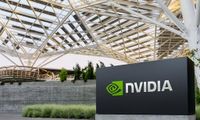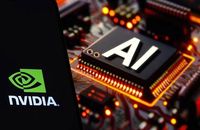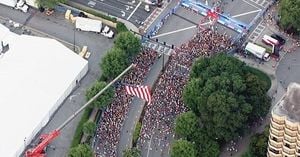Nvidia, the computing giant that has dominated the stock market over the past two years, is making headlines again as its founder and CEO Jensen Huang sets ambitious growth targets. The company’s stock price has faced pressure in early 2025, but recent announcements at its annual conference suggest Nvidia remains positioned for continued expansion in the AI and robotics sectors.
Nvidia shares have retreated over 18% from their January 2025 highs. This pullback comes after extraordinary performance in 2023 and 2024. The current price stands at $120.61 as of March 25, 2025, representing a 0.66% daily decline. Despite this recent weakness, Nvidia’s market capitalization remains impressive at $2.9 trillion. The company has established itself as a central player in the artificial intelligence boom.
At Nvidia’s annual GTC conference, CEO Jensen Huang made a bold prediction. He stated that Nvidia’s data center infrastructure revenue will reach $1 trillion by 2028. This forecast is remarkable considering no company currently generates that level of revenue, with Walmart holding the top position at $673.8 billion in annual revenue. Huang’s projection focuses solely on Nvidia’s data center segment, excluding revenue from other business units.
Over the past four quarters, Nvidia’s data center revenue totaled $115.3 billion, with the most recent quarter showing a staggering 93% year-over-year growth in this segment. Mathematical analysis suggests Huang’s target may be realistic. If Nvidia maintains its current growth rate, it could actually exceed the projection with $1.6 trillion in data center revenue by 2028. The company would need to sustain a compound annual growth rate of 72% to reach the $1 trillion mark. While ambitious, this aligns with recent performance trends.
If Nvidia achieves this revenue goal while maintaining its current 56% profit margin, it would generate $560 billion in profits, far exceeding any company’s current earnings. Based on the S&P 500’s average price-to-earnings ratio of 22.3, such performance could push Nvidia’s market cap to $12.5 trillion, representing roughly 330% stock price appreciation over four years.
Beyond AI computing, Nvidia is also making major moves in robotics. The company recently announced several new technologies aimed at “supercharging humanoid robot development.” The centerpiece is Nvidia Isaac GR00T N1, described as “the world’s first open, fully customizable foundation model for generalized humanoid reasoning and skills.” This architecture mimics human thinking patterns.
Nvidia also introduced simulation frameworks and development blueprints, including the Isaac GR00T Blueprint for generating synthetic data. Another key offering is Newton, an open-source physics engine being developed in partnership with Google DeepMind and Disney Research. This tool enables robots to handle complex tasks with greater precision.
Disney Research is among the first organizations implementing these technologies, using Nvidia’s engine to develop entertainment robots, including Star Wars-inspired BDX droids. Kyle Laughlin of Walt Disney Imagineering emphasized the potential impact: “This collaboration will allow us to create a new generation of robotic characters that are more expressive and engaging than ever before.”
While these technologies appear promising, their immediate financial impact remains uncertain. Nvidia generated $130.5 billion in total revenue last year, so new products need substantial adoption to meaningfully affect results. However, the global opportunity is substantial, as labor shortages worldwide are estimated at more than 50 million people, creating demand for robotic solutions.
Nvidia’s forward-looking valuation appears reasonable compared to tech peers, trading at 26 times forward earnings. The company’s next major growth driver is likely its new Blackwell GPU architecture. During the fourth-quarter earnings call, Huang noted “extraordinary” demand for these products.
Historical patterns suggest the current price pullback may represent an opportunity. Previous dips in Nvidia’s stock have consistently provided strong returns for investors who bought during these periods. However, the company faces potential headwinds, including economic uncertainty and the possibility that major clients could diversify their suppliers. Yet, these risks haven’t materialized in financial results so far.
As Nvidia continues developing both AI computing and robotics technologies, investors will closely monitor quarterly reports to assess whether the company remains on track toward Huang’s ambitious trillion-dollar vision.
In a related development, Apple CEO Tim Cook is visiting China this week, where he praised China’s AI chatbot Deepseek. Apple’s stock gained more than 1% on March 25, 2025, when Cook announced that the popular Chinese video game Wuthering Waves will be coming to the Mac this week. Cook’s positive remarks about Deepseek come amidst concerns from Alibaba’s Chairman Joe Tsai, who worries that the US is entering an AI bubble.
Cook’s praise of Deepseek, which produced a cheaper AI chatbot, has raised eyebrows among US AI executives. Many observers believe an AI partnership is in the works between Deepseek and Apple. Meanwhile, Alibaba has released its own in-house AI platform Qwen 2.5-Max, which it claims surpasses Deepseek’s third version.
Despite announcing a $52 billion long-term investment in AI technology, Tsai expressed skepticism about the necessity of heavy US investment in AI, viewing it as the beginning of a bubble. “People are talking about $500 billion in reference to the Trump administration’s announced partnership with OpenAI and Softbank,” Tsai said at a Hong Kong investment conference. “I don't think that's entirely necessary. I think in a way, people are investing ahead of the demand that they're seeing today.”
Nvidia’s stock has entered a bearish Death Cross on the daily chart, a strong signal that an extended downtrend may lie ahead. If support at $105 fails, shares could quickly drop to $92. In contrast, Apple stock has not yet crossed into a Death Cross but is nearing parity in its moving averages.
Apple has found support over the past two weeks near $210, but a break there could send shares tumbling toward lower supports. Analysts suggest that while Apple is somewhat insulated from an AI downturn, the stock’s high valuation could lead to declines in a broader market sell-off affecting other AI stocks.
As the technology sector navigates these challenges, the performance of both Nvidia and Apple will be closely watched by investors and market analysts alike, as they adapt to the evolving landscape of AI and robotics.






